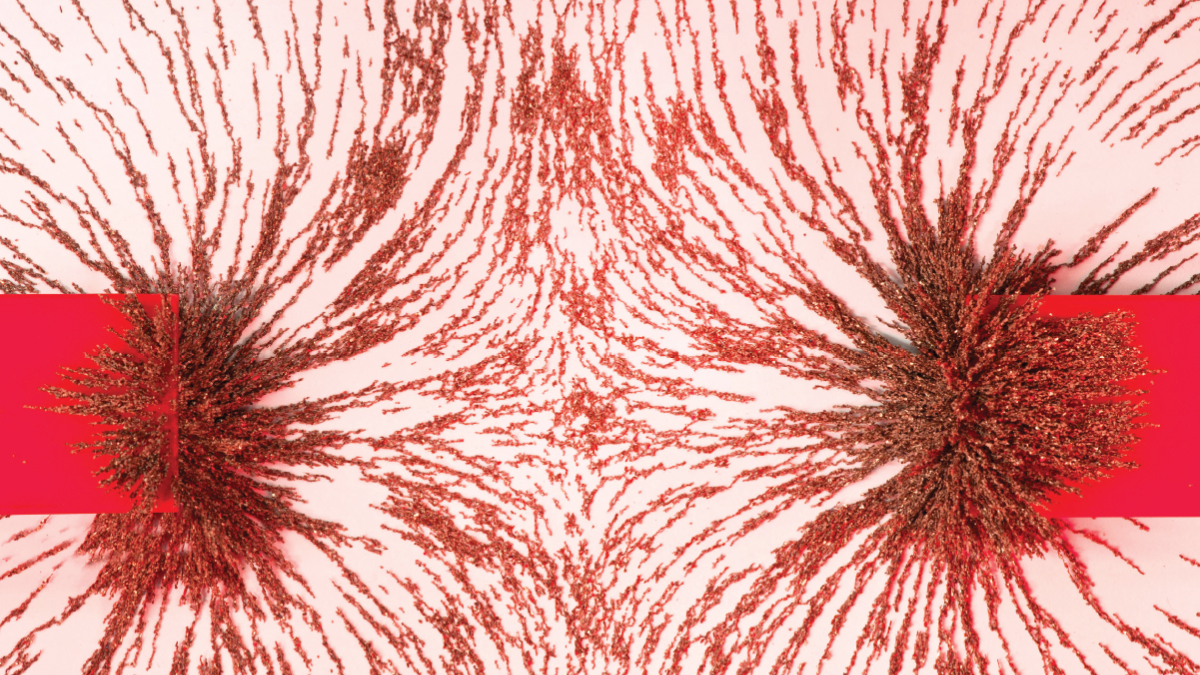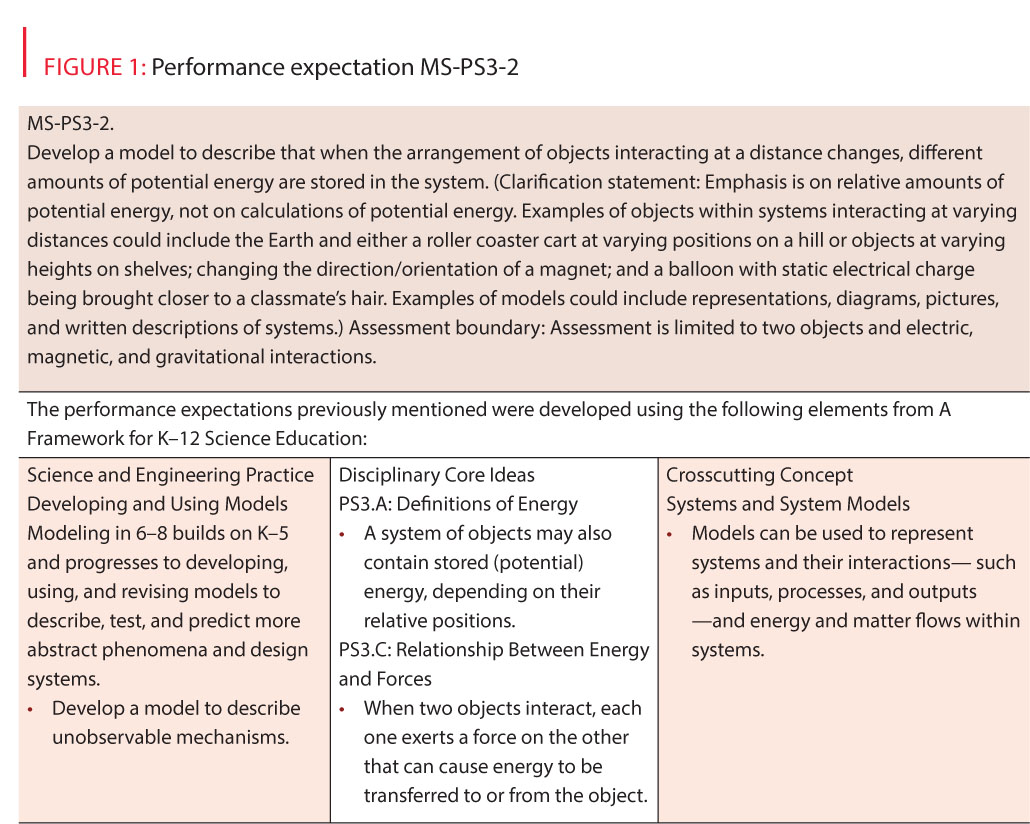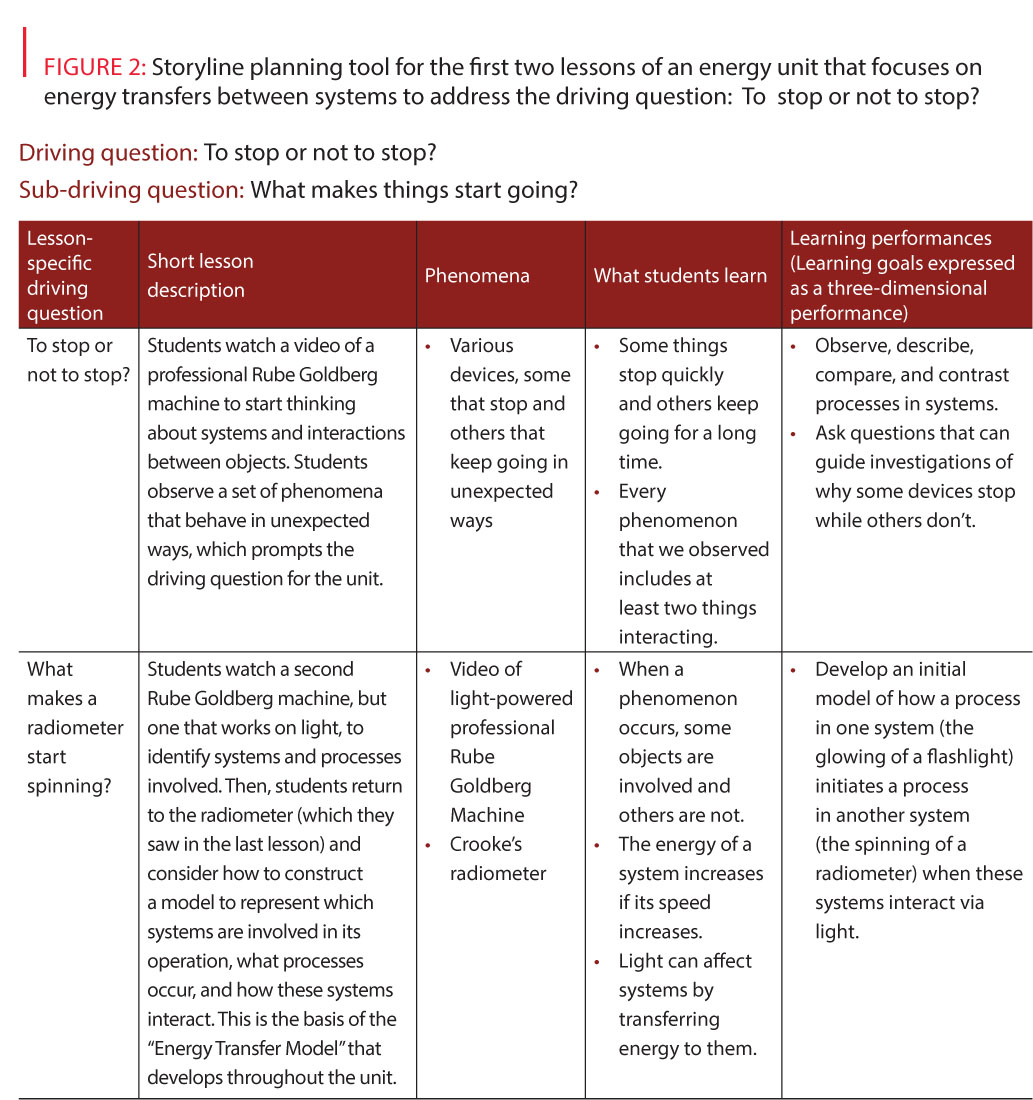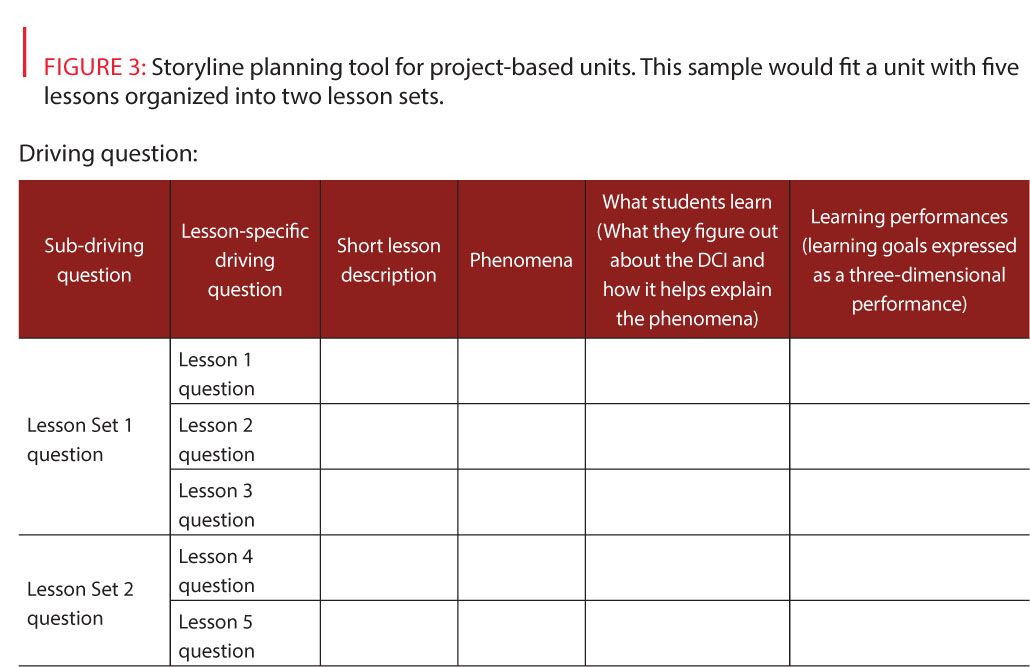Using Storylines to Support Three-Dimensional Learning in Project-Based Science
Science Scope—February 2019 (Volume 42, Issue 6)
By Jeffrey Nordine, Joseph Krajcik, David Fortus, and Knut Neumann

Project-based learning (PBL) engages students via collaboration on sustained investigations to make sense of interesting and meaningful phenomena. Over the last several years, we have worked with classroom teachers to design and enact project-based science units that engage middle grade learners and help them meet important learning goals aligned with the NGSS (NGSS Lead States 2013). We have found that developing storylines for our units allowed us to design coherent learning environments that helped students make sense of phenomena and meet important learning goals. Thinking in terms of storylines has helped us articulate how students can figure out over time, piece-by-piece, the mechanisms governing how a phenomenon works. A storyline shows how the three dimensions of science knowledge—disciplinary core ideas (DCIs), science and engineering practices (SEPs), and crosscutting concepts (CCs)— develop over time to build sophisticated ideas from prior ideas (Krajcik et al. 2014; Reiser, Novak, and McGill 2017).
In this article, we present our process for developing storylines and we share a planning tool that we have used to connect learning experiences into a coherent storyline that runs throughout a project-based science unit. This process has been used by teachers and researchers to develop project-based science units (Bielik, Damelin, and Krajcik 2018). Throughout this article, we give examples of how storylines helped us design a project-based unit to support the type of three-dimensional learning about energy described in A Framework for K–12 Science Education and the NGSS (NRC 2012; NGSS Lead States 2013).
The importance of storylines in developing project-based science units
Good stories have a lot in common with PBL instruction. Both build off our prior experiences, tap into our interests, address meaningful ideas, and foster our continued attention by carefully managing what we know and when we know it. But perhaps most important, good stories raise our curiosity about what is going to happen. PBL instruction should also capture curiosity and have students wonder about the phenomenon that is being investigated. Just like it’s hard to put down a great book or stop binge-watching our favorite TV series, when science instruction unfolds like a great story, students want to know more, and they are puzzled in just the right way at just the right time as they encounter new phenomena and ask new questions. When instruction is organized around a coherent storyline in which students are making sense of phenomena, students know how new science ideas connect to the ones they learned before and they have a sense of what to expect in upcoming lessons. This both sets the stage for learning complex and interconnected ideas, as three-dimensional learning requires, and helps foster and maintain students’ interest.
Many phenomena grab students’ interest, such as freezing objects in liquid nitrogen or making a pickle glow with electric current, but phenomena that make for exciting demonstrations often don’t support sustained investigation or necessarily help meet important learning goals. Coherent storylines can spur and sustain students’ interest if they are introduced in the right manner and at the right time. For example, few students are surprised that when repelling magnetic carts are held close to each other and released, they move away from each other, but a carefully planned storyline can spur their interest by framing how they view this phenomenon.
We use the repelling magnets phenomenon in the context of a PBL unit that addresses a set of middle school performance expectations about energy.
We introduce the repelling magnet phenomenon only after several lessons in which students develop models of phenomena based on the idea that any time the energy of a system increases (such as the repelling magnetic carts as they speed up), energy must have been transferred to the system from another system. In this case, the other system is the magnetic field between the carts. Without studying fields to explain interaction at a distance, students are puzzled by this familiar phenomenon because it seems that energy has only been transferred to the magnetic carts without being transferred from another system. By using a coherent storyline to plan learning experiences, we are able to present this phenomenon so that students will be puzzled in just the right way and able to use existing thinking tools along with the new idea of fields in order to solve it.
Developing storylines from the Next Generation Science Standards’ performance expectations
Just as a good storyteller begins by knowing where the story is headed, project-based units begin by identifying what students should know and be able to do at the end of a project. This is often called backward design (Wiggins and McTighe 2011) or learning-goalsdriven design (Krajcik, McNeill, and Reiser 2008). To define a coherent storyline, we begin by identifying a set of several (but not too many!) performance expectations that will be the target of our unit.
Unpacking performance expectations
The NGSS performance expectations (PEs) integrate the three dimensions of science knowledge to provide a statement of what students should know and be able to do by the end of middle school. Although performance expectations tell us what students should know and give us an idea of where our instructional story is ultimately headed, they are not instructional objectives. To decide which main ideas to emphasize in a coherent storyline, we must first select performance expectations that we plan to address. We have found it helpful to unpack the PEs. By “unpacking” we mean determining which ideas are critical for the learner to understand. The process involves breaking apart and expanding the various dimensions to elaborate what the ideas mean for students at that grade level (Krajcik, McNeill, and Reiser 2008 and Krajcik et al. 2014). We explore the SEPs, DCIs, and CCs addressed within our target PEs. For each dimension, we identify:
- What are the most important ideas that students should know? The foundation boxes of the NGSS are an important guide here, as is the text of the Framework.
- What are the content limits? What prior knowledge is required? We especially use the Framework grade band endpoints as guides here.
- What are common student challenges? Here, we rely on our experiences and prior research (e.g., Science Literacy Maps; see Resources) about student difficulties.
The unpacking process guides instructional planning, but it is important to recognize two key aspects about the PEs: (1) each describes complex learning that develops throughout middle school, seldom in a single unit, and (2) they are designed to guide assessments rather than constrain instruction, so they represent just a sample of what students should be able to do—not the totality of their science learning. Thus, while MS-PS3-2 (see Figure 1) integrates the science and engineering practice of Modeling, elements of the disciplinary core ideas related to potential energy and interactions between objects, and the crosscutting concept of Systems and System Models, a unit that builds toward MS-PS3-2 and should integrate across the dimensions in other ways as well. That is, students should also connect the idea of potential energy to other practices (e.g., argumentation) and crosscutting concepts (e.g., energy and matter flows, cycles, and conservation) as they make sense of phenomena.

Identifying contexts and phenomena
Unpacking the DCI helps in identifying phenomena that will elicit student curiosity and support student investigations. For example, in unpacking the DCI of MS-PS3-2, we identified everyday phenomena such as falling objects and repelling magnets as opportunities for exploring potential energy in systems of objects that interact at a distance. We also identify potential anchoring phenomena (The Cognition and Technology Group at Vanderbilt 1990), which are particularly rich phenomena that can be introduced at the beginning of a unit and drive several weeks of investigation. Unpacking and identifying related phenomena also helps with developing a driving question (Krajcik and Czerniak 2013), which aligns with the anchoring phenomena, helps contextualize and connect between lessons, and builds students’ wonderment. In our energy unit, for example, we ask students to systematically observe a set of anchoring phenomena that behave in unexpected ways (e.g., ice melting quickly on an aluminum block versus slowly on a similar-looking plastic block, “perpetual motion” toys powered by a hidden battery), and pose questions about how they might work. Students make observations of these anchoring phenomena and pose their own questions about these phenomena that lead to the introduction of the driving question: To stop or not to stop?
We also begin to list promising classroom experiences and investigations. We try not to reinvent the wheel—we list experiences and phenomena that we have successfully used with students before and consider how they can be efficiently adapted to suit our purposes.
Considering the unpacked PEs, along with the phenomena, driving questions, and experiences we have identified, we begin to craft learning goals expressed as performances. We call these learning performances (LPs). These LPs specify how students should engage with learning experiences, build toward the PEs, and provide guidance for how student progress can be formatively assessed (Krajcik, McNeill, and Reiser 2008). These LPs, like the PEs, are three-dimensional statements that integrate a SEP, DCI, and a CC. However, the LPs are more specific to particular experiences or phenomena that are included in the unit and may incorporate elements that are not included in the PEs themselves. That is, while a PE may include the practice of modeling, an LP may address the same DCI and CC ideas through investigation design. For example, an LP that relates to the phenomenon of a falling object and builds toward MS-PS3-2 might be “Students gather and analyze data to relate the height from which an object falls to the energy transferred from the gravitational field to the object.” Learning performances also help identify the various artifacts that occur in a project that can be used for assessment purposes. For instance, throughout the unit (see Figure 2) students build various models of energy transfer.
Storyline planning tool
Storylines are driven by the phenomena students are trying to figure out and help connect and motivate learning experiences over the course of several weeks or more. No matter how interesting a single driving question or anchoring phenomenon might be, students need access to new questions and phenomena during a multiweek unit. This is where subdriving questions come in—you might think of them as a subplot that is critical for understanding the full story. Sub-driving questions focus on specific aspects of the driving question or anchoring phenomena and connect a subset of lessons that we call a learning set. Often as students ask their own questions related to the anchoring phenomena and activities in the unit, they ask these sub-driving questions. For example, the anchoring activity may spur the subdriving question “What makes things start going?” while later lessons may prompt students to ask another sub-driving question, “How can energy be transferred even when objects don’t touch?” Further, sub-driving questions can be divided into lesson-specific driving questions that guide learning experiences within individual lessons.
While the driving question, sub-driving questions, and lesson-specific driving questions give a broad context to a project-based unit, it is the details of the storyline that truly specify how ideas should build during instruction and how student interest can be fostered and sustained. We find that the Storyline Planning Tool in Figure 3 is a useful template for specifying a project-based unit storyline.
The Storyline Planning Tool consists of six columns. The first two columns specify the questions that connect the sub-driving questions and the lessonspecific driving questions. The “Lesson Description” column briefly describes the learning experiences in the lesson and how the lesson connects to adjacent lessons. The next column, “Phenomena,” lists what natural phenomena or designed devices students will investigate. Good units involve a wide range of accessible and vivid phenomena with which students can interact on a firsthand basis, but they are driven by students making sense of one or a few anchoring phenomena. The “What Students Learn” column identifies the science ideas that students are figuring out as a result of the experience and links to the LP. Just as the author of a novel knows what has been revealed to the reader about each character in each book chapter, this column specifies what key science ideas have been revealed to and by students at each point in the unit. The final column, “Learning Performances,” lists the three-dimensional LPs that describe how students should engage with the phenomena. Each lesson typically only has one or two learning performances at the most—after all, the point of a coherent storyline is to make sure that students’ are attending to the most central ideas at the right time. The Storyline Planning Tool can help quickly organize your thinking about how project-based units coherently build ideas throughout instruction.
Figure 2 shows how we have used the Storyline Planning Tool to plan a unit on energy, which emphasizes students’ ability to use energy transfers between systems to explore why some things stop quickly while others keep on going for a long time. The full storyline can be found online (see Online Supplemental Materials). It is important to realize that while we have described this process in a linear manner, it is very nonlinear process. Often, writing a learning performance will prompt our thinking of other phenomena. Classroom enactment also provides insights into the questions students will ask that will require a shifting focuses of the storyline.


Conclusion
We have used this storyline to develop a unit that has been used in several middle school classrooms. Our research (Kubsch et al. 2017) shows that when students engage in this project-based unit, they develop sophisticated understanding of the ideas in the performance expectations. See Resources to learn more about the “ELeVATE: Investigating How Students Build an Integrated Understanding of Energy Over Time” project.
Storylines are a valuable tool for planning projectbased science instruction because they help define a trajectory for student learning that both spurs new learning and maintains student interest throughout a weeks-long unit. By taking a page from our favorite storytellers, science instruction can use the power of a good story to realize the power of project-based instruction
ACKNOWLEDGMENT
This work was supported by a grant from the National Science Foundation (Award # DUE-143172).
RESOURCES
ELeVATE—http://create4stem.msu.edu/node/3431
Science literacy maps—http://strandmaps.dls.ucar.edu
General Science NGSS Three-Dimensional Learning Middle School


